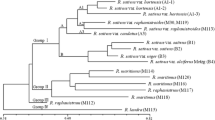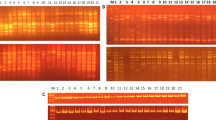Abstract
The utility of RFLP (restriction fragment length polymorphism), RAPD (random-amplified polymorphic DNA), AFLP (amplified fragment length polymorphism) and SSR (simple sequence repeat, microsatellite) markers in soybean germplasm analysis was determined by evaluating information content (expected heterozygosity), number of loci simultaneously analyzed per experiment (multiplex ratio) and effectiveness in assessing relationships between accessions. SSR markers have the highest expected heterozygosity (0.60), while AFLP markers have the highest effective multiplex ratio (19). A single parameter, defined as the marker index, which is the product of expected heterozygosity and multiplex ratio, may be used to evaluate overall utility of a marker system. A comparison of genetic similarity matrices revealed that, if the comparison involved both cultivated (Glycine max) and wild soybean (Glycine soja) accessions, estimates based on RFLPs, AFLPs and SSRs are highly correlated, indicating congruence between these assays. However, correlations of RAPD marker data with those obtained using other marker systems were lower. This is because RAPDs produce higher estimates of interspecific similarities. If the comparisons involvedG. max only, then overall correlations between marker systems are significantly lower. WithinG. max, RAPD and AFLP similarity estimates are more closely correlated than those involving other marker systems.
Similar content being viewed by others
Abbreviations
- RFLP:
-
restriction fragment length plymorphism
- RAPD:
-
random-amplified polymorphic DNA
- AFLP:
-
amplified fragment length polymorphism
- SSR:
-
simple sequence repeat
- PCR:
-
polymerase chain reaction
- TBE:
-
Tris-borate-EDTA buffer
- MI:
-
marker index
- SENA:
-
sum of effective numbers of alleles
References
Akkaya MS, Bhagwat AA, Cregan PB: Length polymorphism of simple sequence repeat DNA in soybean. Genetics 132: 1131–1139 (1992).
Beckmann JS, Soller M: Restriction fragment length polymorphisms in genetic improvement: methodologies, mapping and costs. Theor Appl Genet 67: 35–43 (1983).
Bell CJ, Ecker JR: Assignment of thirty microsatellite loci to the linkage map ofArabidopsis. Genomics 19: 137–144 (1994).
Botstein D, White RL, Skolnick MH, Davis RW: Construction of a genetic map in man using restriction fragment length polymorphisms. Am J Hum Genet 32: 314–331 (1980).
Bowcock AM, Ruiz-Linares A, Tomfohrde J, Minch E, Kidd JR, Cavalli-Sforza LL: High resolution of human evolutionary trees with polymorphic microsatellites. Nature 368: 455–457 (1994).
Caetano-Anolles G, Bassam BJ, Gresshoff PM: High resolution DNA amplification fingerprinting using very short arbitrary oligonucleotide primers. Bio/technology 9: 553–557 (1991).
Coe JE.H., Neuffer MG, Hoisington DA: The genetics of corn. In: Sprague GF, Dudley JW (eds) Corn and Corn Improvement, pp. 81–258. American Society of Agronomy, Madison, WI (1988).
Cornall RJ, Aitman TJ, Hearne CM, Todd JA: The generation of a library of PCR-analyzed microsatellite variants for genetic mapping of the mouse genome. Genomics 10: 874–881 (1991).
Delanney X, Rodgers DM, Palmer RG: Relative genetic contributions among ancestral lines to North-American soybean cultivars. Crop Sci 23: 944–949 (1983).
Dietrich W, Katz H, Lincoln SE, Shin H-S, Friedman J, Dracopoli NC, Lander ES: A genetic map of the mouse suitable for typing intraspecific crosses. Genetics 131: 423–447 (1992).
dosSantos JB, Nienhuis J, Skroch P, Tivang J, Slocum MK: Comparison of RAPD and RFLP genetic markers in determining genetic similarity amongBrassica oleracea L. genotypes. Theor Appl Genet 87: 909–915 (1994).
Gregorius HR: The relationship between the concepts of genetic diversity and differentiation. Theor Appl Genet 74: 397–401 (1987).
Hallden C, Nilsson N-O, Rading IM, Saell T: Evaluation of RFLP and RAPD markers in comparison of Brassica napus breeding lines. Theor Appl Genet 88: 123–128 (1994).
Hymowitz T, Bernard RL: Origin of the soybean and germplasm introduction and development in North American. In:Use of Plant Introductions in Cultivar Development, Part I CSSA Special Publication 17, pp. 147–164. Crop Science Society of America, Madison, WI (1991).
Lawler FC, Stoffel S, Saiki RK, Chang S-Y, Landre PA, Abramson RD, Gelfand DH: High-level expression, purification, and enzymatic characterization of full-lengthThermus aquaticus DNA polymerase and a truncated form deficient in 5′ to 3′ exonuclease activity. PCR Meth Appl 2: 275–287 (1993).
Li Z, Furnier GR: Comparison of allozyme, RFLP, and RAPD markers for revealing genetic variation within and between trembling aspen and bigtooth aspen. Theor Appl Genet 87: 97–105 (1993).
Lin J-J, Kuo J: AFLPTM: A Novel PCR-Based Assay for Plant and Bacterial DNA Fingerprinting. Focus 17: 66–70 (1995).
Mantel N: The dedection of disease clustering and a generalized regression approach. Cancer Res 27: 209–220 (1967).
Marshall DR, Allard RW: Isozyme polymorphisms in natural populations ofAven fatua andAvena barbata. Heredity 25: 373–382 (1970).
Morgante M, Olivieri AM: PCR-amplified microsatellites as markers in plant genetics. Plant J 3: 175–182 (1993).
Morgante M, Rafalski JA, Biddle P, Tingey S, Olivieri AM: Genetic mapping and variability of seven soybean simple sequence repeat loci. Genome 37: 763–769 (1994).
Nei M: Analysis of gene diversity in subdivided populations. Proc Natl Acad Sci USA 70: 3321–3323 (1973).
Nei M, Li WH: Mathematical model for studying genetic variation in terms of restriction endonucleases. Proc Natl Acad Sci USA 76: 5269–5273 (1979).
Parks C, Chang L-S, Shenk T: A polymerase chain reaction mediated by a single primer: cloning of genomic sequences adjacent to a serotonin receptor protein coding region. Nucl Acids Res 19: 7155–7160 (1991).
Peakall R, Smouse PE, Huff DR: Evolutionary Implications of allozyme and RAPD variation in diploid populations of dioecious buffalograssBuchloe dactyloides. Mol Ecol 4: 135–147 (1995).
Rafalski A, Tingey S: RFLP map of soybean (Glycine max) 2n=40. In: O'Brien SJ (ed) Genetic Maps. Locus Maps of Complex Genomes. Cold Spring Harbor Laboratory Press, Cold Spring Harbor, NY (1993).
Rafalski A, Tingey S, Williams JGK: Random amplified polymorphic DNA (RAPD) markers. In: Gelvin SB, Schilperoort RA, Eds. Plant Molecular Biology Manual, pp. 1–8. Kluwer Academic Publishers, Dordrecht (1994).
Rafalski JA, Morgante M, Powell W, Vogel JM, Tingey SV: Generating and using DNA markers in plants. In: Birren B, Lai E, (eds)Analysis of Non-mammalian Genomes: A practical Guide, press. Academic Press, Boca Raton, FL (1996).
Rafalski JA, Tingey SV: Genetic diagnostics in plant breeding: RAPDs, microsatellites and machines. Trends Genet 9: 275–280 (1993).
Rohlf FJ: NTSYS-pc Numerical Taxonomy and Multivariate Analysis System version 1.7. Owner manual (1992).
Rongwen J, Akkaya MS, Bhagwat AA, Lavi U, Cregan PB: The use of microsatellite DNA markers for soybean genotype identification. Theor Appl Genet 90: 43–48 (1995).
Rus-Kortekass W, Smulders MJM, Arens P, Vosman B: Direct comparison of levels of genetic variation in tomato detected by a GACA-containing microsatellite probe and by random amplified polymorphic DNA. Genome 37: 375–381 (1994).
Saghai Maroof MA, Biyashev RM, Yang GP, Zhang Q, Allard RW: Extraordinarily polymorphic microsatellite DNA in Barley: Species diversity, chromosomal locations, and population dynamics. Proc Natl Acad Sci USA 91: 5466–5470 (1994).
Sambrook J, Fritsch EF, Maniatis T: Molecular Cloning: A Laboratory Manual, 2nd ed. Cold Spring Harbor Laboratory, Cold Spring Harbor, NY (1989).
Senior ML, Heun M: Mapping maize microsatellites and polymerase chain reaction confirmation of the targeted repeats using a CT primer. Genome 36: 884–889 (1993).
Serikawa T, Kuramoto T, Hilbert P, Mori M, Yamada J, Dubay CJ, Lindpainter K, Ganten D, Guenet J-L, Lathrop GM, Beckman JS: Rat gene mapping using PCR-analyzed microsatellites. Genetics 131: 701–721 (1992).
Smith OS, Smith JSC, Bowen SL, Tenborg RA, Wall SJ: Similarities among a group of elite maize inbreds as measured by pedigree, F1 grain-yield, heterosis and RFLPs. Theor Appl Genet 80: 833–840 (1990).
Sokal RR, Michener CD: A statistical method for evaluating systematic relationships. Univ Kansas Sci Bull 38: 1409–1438 (1958).
Tautz D: Hypervariability of simple sequences as a general source for polymorphic DNA markers. Nucl Acids Res 17: 6463–6471 (1989).
Tautz D, Renz M: Simple sequences are ubiquitous repetitive components of eukaryotic genomes. Nucl Acids Res 12: 4127–4138 (1984).
Tautz D, Trick M, Dover GA: Cryptic simplicity in DNA is a major source of genetic variation. Nature 322: 652–656 (1986).
Thomas MR, Cain P, Scott NS: DNA typing of grapwvine: A universal methodology and database for describing cultivars and evaluating genetic relatedness. Plant Mol Biol 25: 939–949 (1994).
Thomas MR, Scott NS: Microsatellite repeats in grapevine reveal DNA polymorphisms when analysed as sequence-tagged sites (STSs). Theor Appl Genet 86: 985–990 (1993).
Thormann CE, Ferreira ME, Camargo LEA, Tivang JG, Osborn TC: Comparison of RFLP and RAPD markers to estimating genetic relationships within and among cruciferous species. Theor Appl Genet 88: 973–980 (1994).
Tibayrenc M, Neubauer K, Barnabe C, Guerrini F, Skarecky D, Ayala FJ: Genetic characterization of six parazitic protozoa: Parity between random-primer DNA typing and multilocus enzyme electrophoresis. Proc Natl Acad Sci USA 90: 1335–1339 (1993).
Tingey SV, delTufo JP: Genetic Analysis with RAPD Marklers. Plant Physiol 101: 349–352 (1993).
Todd JA: La carte des microsatellites est arrivé! Human Mol Genet 1: 663–666 (1992).
Waugh R, Powell W: Using RAPD markers for crop improvement. Trends Bio/technol 10: 186–191 (1992).
Weber J, May PE: Abundant class of human DNA polymorphisms which can be typed using the polymerase chain reaction. Am J Hum Genet 44: 388–396 (1989).
Weissenbach J Ed.: The Genethon microsatellite map catalogue. Genethon, Evry, France (1992).
Welsh J, McClelland M: Fingerprinting genomes using PCR with arbitrary primers. Nucl Acids Res 18: 7213–7218 (1990).
Whitkus R, Doebley J, Wendel JF: Nuclear DNA Markers in systematics and evolution. In: Phillips RL, Vasil IK (eds) DNA Based Markers in Plants pp. 116–141. Kluwer Academic Publishers, Dordrecht (1994).
Williams JGK, Kubelik AR, Livak KJ, Rafalski JA, Tingey SV: DNA polymorphisms amplified by arbitrary primers are useful as genetic markers. Nucl Acids Res 18: 6531–6535 (1990).
Williams JGK, Rafalski JA, Tingey SV: Genetic analysis using RAPD markers. Meth Enzymol 218: 704–780 (1993).
Wu K-S, Tanksley SD: Abundance, polymorphism and genetic mapping of microsatellites in rice. Mol Gen Genet 241: 225–235 (1993).
Yang GP, Saghai Maroof MA, Xu CG, Zhang Q, Biyashev RM: Comparative analysis of microsatellite DNA polymorphism in landraces and cultivars of rice. Mol Gen Genet 245: 187–194 (1994).
Zabeau M, Voss P: Selective restriction fragment amplification: a general method for DNA fingerprinting. European Patent Application 92402629.7 (1993).
Author information
Authors and Affiliations
Rights and permissions
About this article
Cite this article
Powell, W., Morgante, M., Andre, C. et al. The comparison of RFLP, RAPD, AFLP and SSR (microsatellite) markers for germplasm analysis. Mol Breeding 2, 225–238 (1996). https://doi.org/10.1007/BF00564200
Received:
Accepted:
Issue Date:
DOI: https://doi.org/10.1007/BF00564200




